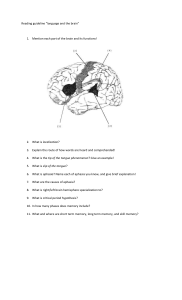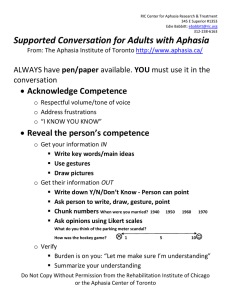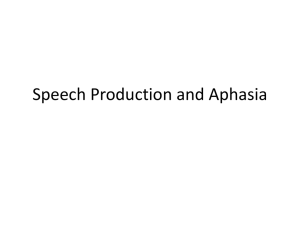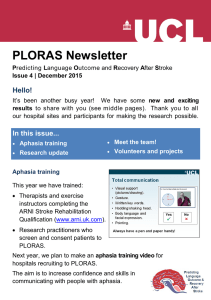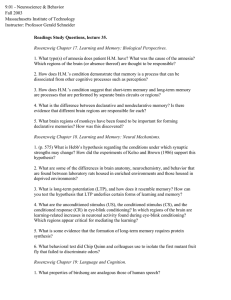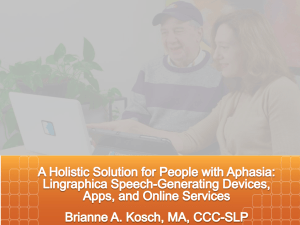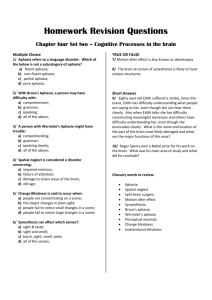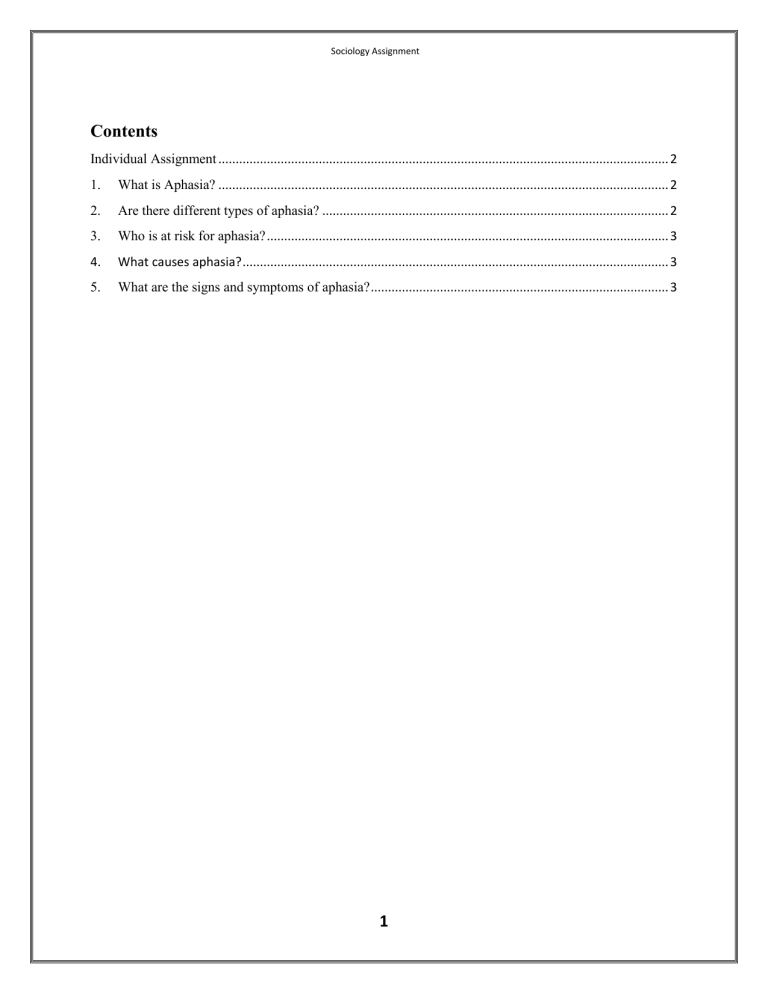
Sociology Assignment Contents Individual Assignment .................................................................................................................................. 2 1. What is Aphasia? .................................................................................................................................. 2 2. Are there different types of aphasia? .................................................................................................... 2 3. Who is at risk for aphasia? .................................................................................................................... 3 4. What causes aphasia? ........................................................................................................................... 3 5. What are the signs and symptoms of aphasia? ...................................................................................... 3 1 Sociology Assignment Individual Assignment 1. What is Aphasia? Aphasia is a disorder that results from damage to areas of the brain that produce and process language. A person with aphasia can have trouble speaking, reading, writing, and understanding language. Impairment in these abilities can range from mild to very severe (nearly impossible to communicate in any form). Some people with aphasia have difficulty in only one area of communication, such as trouble putting words together into meaningful sentences, trouble reading, or difficulty understanding what others are saying. More commonly, people with aphasia are limited in more than one communication area. Nearly all patients with aphasia have wordfinding difficulties that are, coming up with the correct name of persons, places, things, or events. 2. Are there different types of aphasia? There are many types of aphasia. In addition, there are several ways to categorize the different types of aphasia. One common way categorizes aphasia based on three factors: Speech fluency: Can the person speak with ease and in sentences (fluent) or can they only speak a few words at a time and with great effort (non-fluent)? Language comprehension: Does the person have good or poor understanding of spoken or written words? Ability to repeat: Can the person repeat words and phrases? Many clinicians also broadly define aphasia by expressive or receptive types: Expressive: How much trouble does the person have expressing thoughts and ideas through speech or writing? Receptive: How much trouble does the person have understanding spoken language or reading? 2 Sociology Assignment 3. Who is at risk for aphasia? Aphasia can happen to anyone, regardless of age; however, it is more common in those who are middle-aged and older. In the Unites States, approximately 1 million people have aphasia, according to the National Aphasia Association. In addition, about 180,000 people are diagnosed with aphasia each year 4. What causes aphasia? Aphasia results from damage to one or more of the areas of the brain responsible for language. Aphasia can occur suddenly, such as after a stroke (most common cause) or head injury or brain surgery, or may develop more slowly, as the result of a brain tumor, brain infection or neurological disorder such as dementia. Related issues. Brain damage can also result in other problems that affect speech. These problems include dysarthrias (weakness or lack of control in the muscles of the face or mouth resulting in slowed or slurred speech), apraxia (inability to move lips or tongue in the right way to say sounds) and dysphagia (swallowing problems). 5. What are the signs and symptoms of aphasia? Signs and symptoms of aphasia vary depending on the portion of the brain affected, extent of the area affected and type of aphasia. Possible symptoms include: Trouble naming objects, places, events or people even though they are known to the person (“tip of the tongue” phenomenon) Trouble expressing oneself (finding the right words) when speaking or writing Trouble understanding conversation Trouble reading Trouble spelling Leaving out small words like “the,” “of” and “was” from speech Putting words in the wrong order Being unaware of mistakes in one’s spoken language Speaking only in short phrases, which are produced with great effort Speaking in single words 3 Sociology Assignment Making up words Mixing up sounds in words (saying “wog dalker” for “dog walker”) Saying the wrong word (saying “bird” instead of “dog”) or substituting a word that doesn’t make sense (saying “ball” for “phone”) Speech limited to only a few words or repeating the same words or phrases over and over Trouble putting words together to write sentences Trouble using numbers or doing math 6. How is aphasia diagnosed? Imaging tests, such as magnetic resonance imaging (MRI) and computed tomography (CT) may be ordered. These tests identify the cause and areas of the brain that are damaged. Your physician may perform a basic language skills exam in which the patient is asked to carry on a conversation, name objects, answer questions and follow instructions. If your physician suspects aphasia, the patient is usually referred to a speech-language pathologist for a comprehensive exam. This healthcare professional is specially trained in identifying and improving language and communication abilities. The speech-language pathologist will conduct tests to assess abilities such as grammar, ability to form sounds and letters, understanding (comprehension) of words and sentences, and object knowledge. Tests may involve picture descriptions, using single words to name objects and pictures, matching spoken words to pictures, answering yes/no questions, following directions and other tests. 7. How is aphasia treated? Treatment is aimed at improving language and communication abilities and developing other communication methods as needed. Rehabilitation, with a speech-language pathologist, includes reading and writing exercises, listening and repeating wording exercises, learning expressive language skills such as using facial expressions and gestures to communicate, following direction exercises and many more exercises. If traditional ways of learning to communicate are not successful, patients are also taught other ways to communicate, such as pointing to cards with words, pictures or drawings. Handheld computers, tablets devices, smartphones with accompanying “apps” can help people with aphasia communicate. 4
